Seat Ibiza ST 2016 Owner's manual
Manufacturer: SEAT, Model Year: 2016, Model line: Ibiza ST, Model: Seat Ibiza ST 2016Pages: 252, PDF Size: 5.56 MB
Page 131 of 252
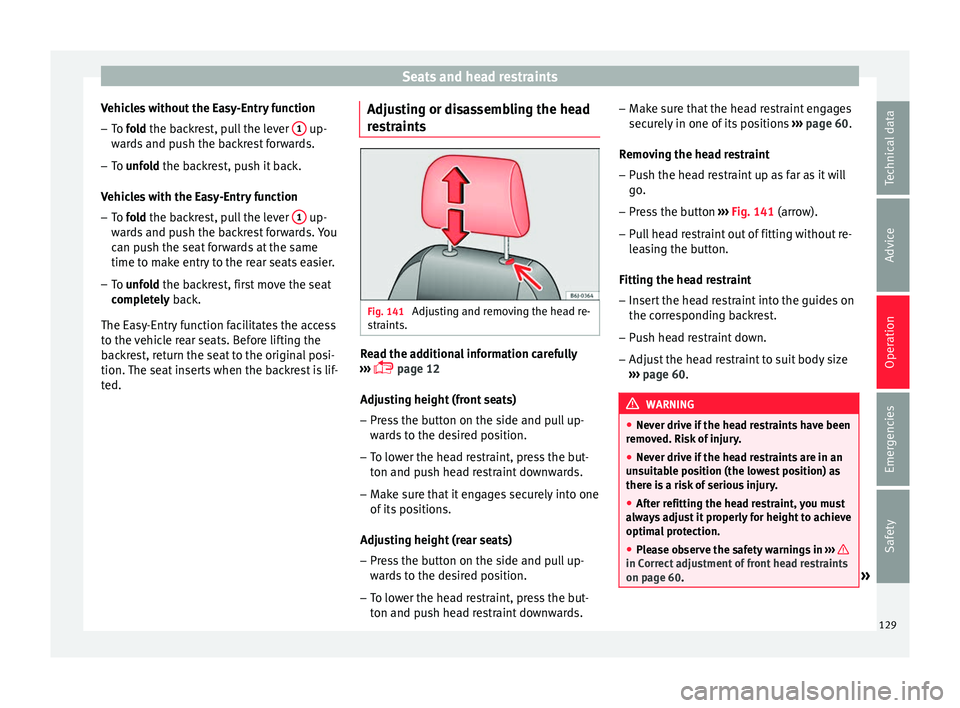
Seats and head restraints
Vehicles without the Easy-Entry function
â To f old the backrest, pull the lever 1 up-
w ar
ds
and push the backrest forwards.
â To unfold the backrest, push it back.
Vehicl
es with the Easy-Entry function
â To fold the backrest, pull the lever 1 up-
w ar
ds
and push the backrest forwards. You
can push the seat forwards at the same
time to make entry to the rear seats easier.
â To unfold the backrest, first move the seat
compl
etely back.
The Easy-Entry function facilitates the access
to the vehicle rear seats. Before lifting the
backrest, return the seat to the original posi-
tion. The seat inserts when the backrest is lif-
ted. Adjusting or disassembling the head
restr
aints Fig. 141
Adjusting and removing the head re-
s tr
aints. Read the additional information carefully
⺠âº
âº
ï¨ p
age 12
Adjusting height (front seats)
â Press the button on the side and pull up-
wards
to the desired position.
â To lower the head restraint, press the but-
ton and push he
ad restraint downwards.
â Make sure that it engages securely into one
of its pos
itions.
Adjusting height (rear seats)
â Press the button on the side and pull up-
wards
to the desired position.
â To lower the head restraint, press the but-
ton and push he
ad restraint downwards. â
Make sur
e that the head restraint engages
securely in one of its positions âºâºâº page 60.
Removing the head restraint â Push the head restraint up as far as it will
go.
â Pre
ss the button âºâºâº Fig. 141
(arrow).
â Pull head restraint out of fitting without re-
leas
ing the button.
Fitting the head restraint
â Insert the head restraint into the guides on
the corres
ponding backrest.
â Push head restraint down.
â Adjust the head restraint to suit body size
âºâºâº p
age 60. WARNING
â Never drive if the he
ad restraints have been
removed. Risk of injury.
â Never drive if the head restraints are in an
unsuit
able position (the lowest position) as
there is a risk of serious injury.
â After refitting the head restraint, you must
alway
s adjust it properly for height to achieve
optimal protection.
â Please observe the safety warnings in âºâºâº in Correct adjustment of front head restraints
on page 60
. » 129
Technical data
Advice
Operation
Emergencies
Safety
Page 132 of 252
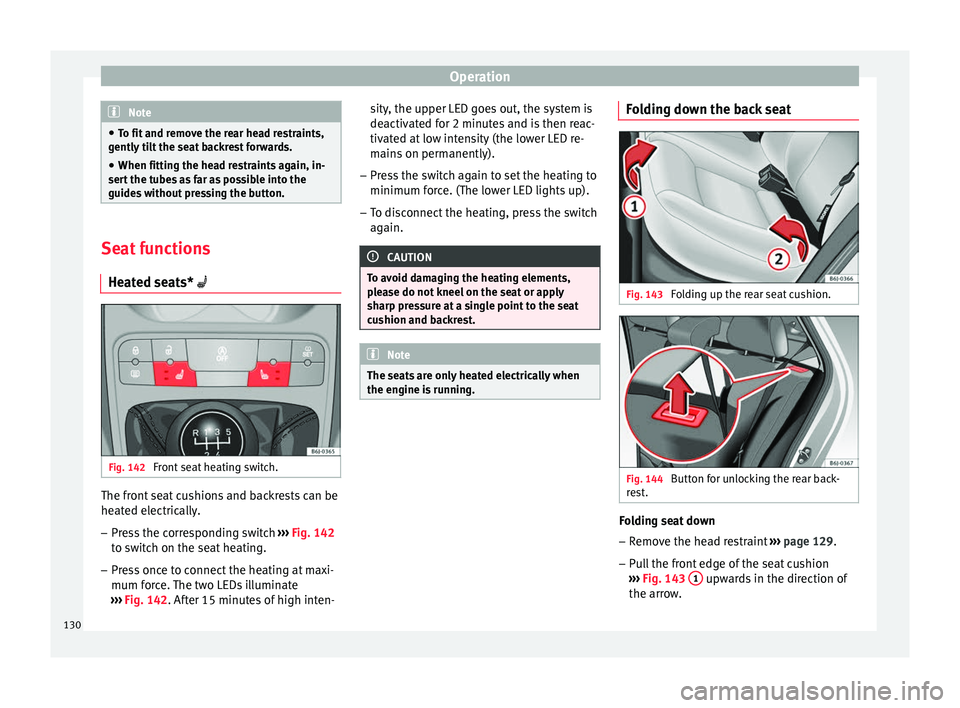
Operation
Note
â To fit and r emo
ve the rear head restraints,
gently tilt the seat backrest forwards.
â When fitting the head restraints again, in-
sert the tube
s as far as possible into the
guides without pressing the button. Seat functions
Heated se at
s* ï¡Fig. 142
Front seat heating switch. The front seat cushions and backrests can be
he
at
ed el ectric
ally.
â Press the corresponding switch âºâºâº Fig. 142
t
o switch on the seat heating.
â Press once to connect the heating at maxi-
mum force.
The two LEDs illuminate
âºâºâº Fig. 142. After 15 minutes of high inten- sity, the upper LED goes out, the system is
deactivated f
or 2 minutes and is then reac-
tivated at low intensity (the lower LED re-
mains on permanently).
â Press the switch again to set the heating to
minimum force. (The lo
wer LED lights up).
â To disconnect the heating, press the switch
again. CAUTION
To avoid damaging the heating elements,
ple a
se do not kneel on the seat or apply
sharp pressure at a single point to the seat
cushion and backrest. Note
The seats are only heated electrically when
the engine is ru
nning. Folding down the back seat
Fig. 143
Folding up the rear seat cushion. Fig. 144
Button for unlocking the rear back-
r e
st
. Folding seat down
â Remove the head restraint âºâº
âº
p
age 129.
â Pull the front edge of the seat cushion
âºâºâº Fig. 143
1 upwards in the direction of
the arr o
w .
130
Page 133 of 252
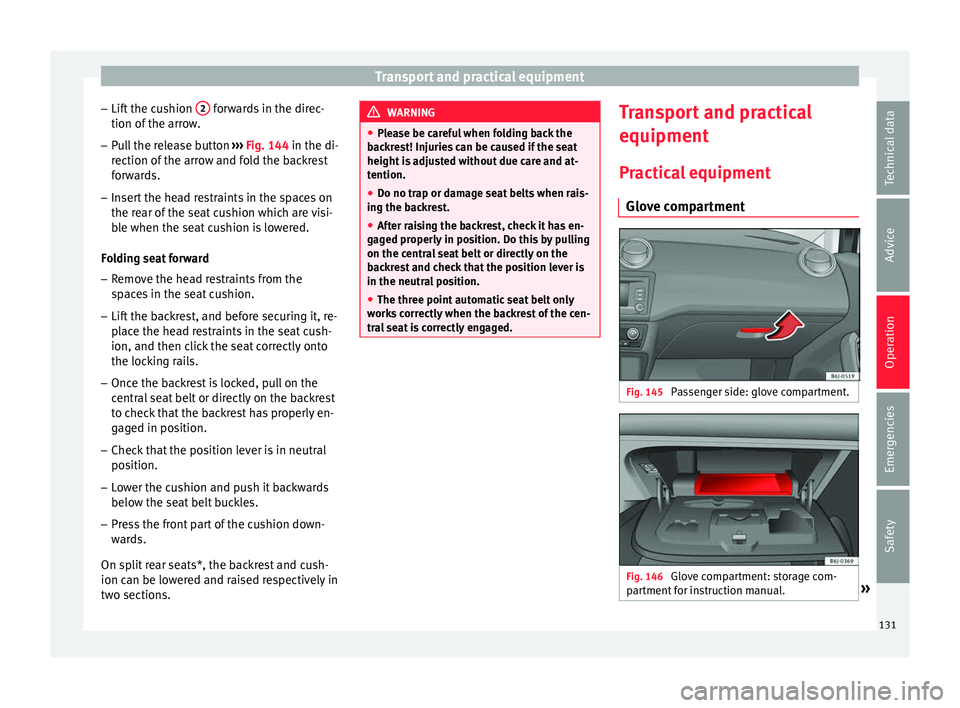
Transport and practical equipment
â Lif t
the c u
shion 2 forwards in the direc-
tion of the arr
ow
.
â Pull the release button âºâºâº Fig. 144 in the di-
r
ection of the arrow and fold the backrest
forwards.
â Insert the head restraints in the spaces on
the rear of the se
at cushion which are visi-
ble when the seat cushion is lowered.
Folding seat forward
â Remove the head restraints from the
space
s in the seat cushion.
â Lift the backrest, and before securing it, re-
place the he
ad restraints in the seat cush-
ion, and then click the seat correctly onto
the locking rails.
â Once the backrest is locked, pull on the
central se
at belt or directly on the backrest
to check that the backrest has properly en-
gaged in position.
â Check that the position lever is in neutral
position.
â Lo
wer the cushion and push it backwards
below the seat belt
buckles.
â Press the front part of the cushion down-
wards.
On s
plit rear seats*, the backrest and cush-
ion can be lowered and raised respectively in
two sections. WARNING
â Plea se be c
areful when folding back the
backrest! Injuries can be caused if the seat
height is adjusted without due care and at-
tention.
â Do no trap or damage seat belts when rais-
ing the back
rest.
â After raising the backrest, check it has en-
gaged properly
in position. Do this by pulling
on the central seat belt or directly on the
backrest and check that the position lever is
in the neutral position.
â The three point automatic seat belt only
works c
orrectly when the backrest of the cen-
tral seat is correctly engaged. Transport and practical
equipment
Pr actic
al
equipment
Glove compartment Fig. 145
Passenger side: glove compartment. Fig. 146
Glove compartment: storage com-
p ar tment
f
or instruction manual. » 131
Technical data
Advice
Operation
Emergencies
Safety
Page 134 of 252
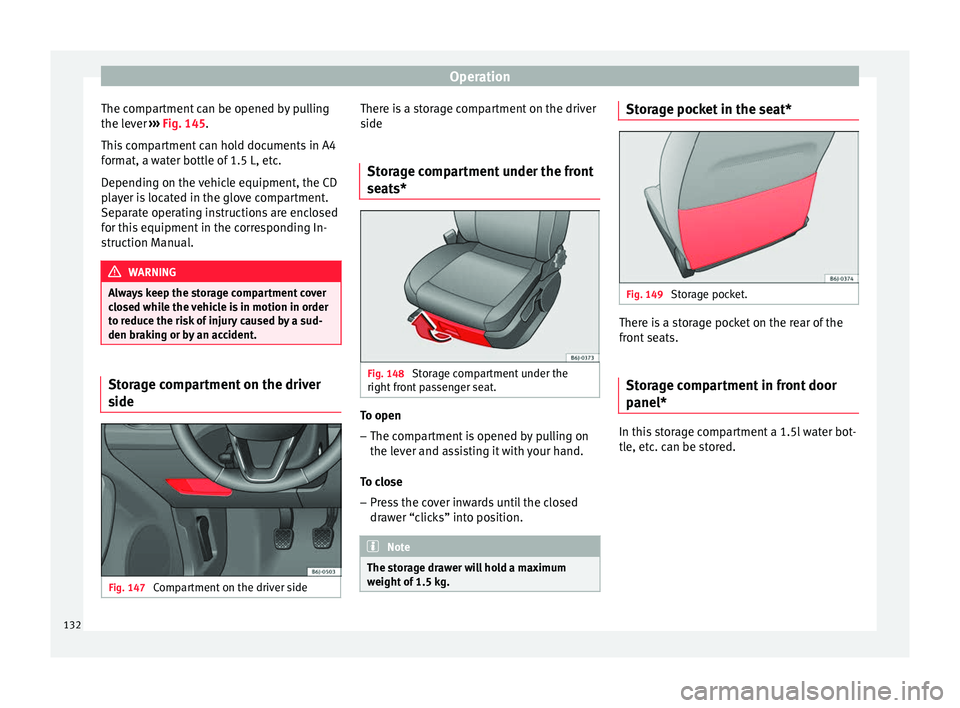
Operation
The compartment can be opened by pulling
the l ev
er âºâº
⺠Fig. 145.
This compartment can hold documents in A4
format, a water bottle of 1.5 L, etc.
Depending on the vehicle equipment, the CD
player is located in the glove compartment.
Separate operating instructions are enclosed
for this equipment in the corresponding In-
struction Manual. WARNING
Always keep the storage compartment cover
closed whi l
e the vehicle is in motion in order
to reduce the risk of injury caused by a sud-
den braking or by an accident. Storage compartment on the driver
s
ide Fig. 147
Compartment on the driver side There is a storage compartment on the driver
s
ide
St orag
e compartment under the front
seats* Fig. 148
Storage compartment under the
right fr
ont p
assenger seat. To open
â The compartment is opened by pulling on
the l ev
er and a s
sisting it with your hand.
To close â Press the cover inwards until the closed
drawer âc
licksâ into position. Note
The storage drawer will hold a maximum
weight of 1.5 k
g. Storage pocket in the seat*
Fig. 149
Storage pocket. There is a storage pocket on the rear of the
fr
ont
seats.
St
orage compartment in front door
panel* In this storage compartment a 1.5l water bot-
tl
e, et
c. c
an be stored.
132
Page 135 of 252
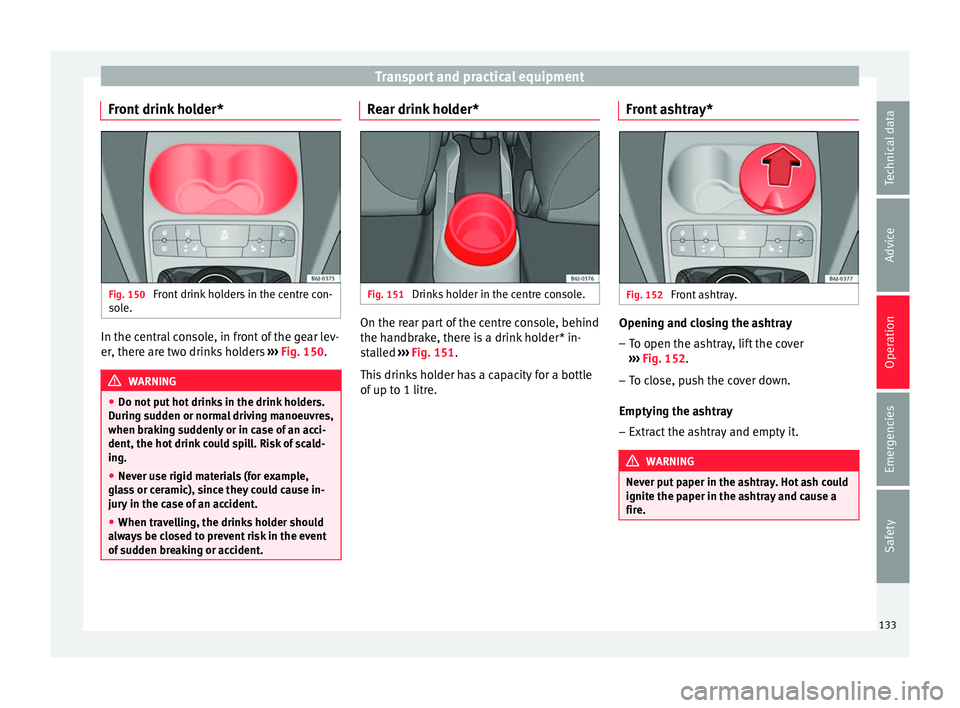
Transport and practical equipment
Front drink holder* Fig. 150
Front drink holders in the centre con-
so l
e. In the central console, in front of the gear lev-
er
, ther
e are tw
o drinks holders âºâºâº Fig. 150. WARNING
â Do not put hot
drinks in the drink holders.
During sudden or normal driving manoeuvres,
when braking suddenly or in case of an acci-
dent, the hot drink could spill. Risk of scald-
ing.
â Never use rigid materials (for example,
glass
or ceramic), since they could cause in-
jury in the case of an accident.
â When travelling, the drinks holder should
alway
s be closed to prevent risk in the event
of sudden breaking or accident. Rear drink holder*
Fig. 151
Drinks holder in the centre console. On the rear part of the centre console, behind
the h
andbr
ake, ther
e is a drink holder* in-
stalled âºâºâº Fig. 151.
This drinks holder has a capacity for a bottle
of up to 1 litre. Front ashtray* Fig. 152
Front ashtray. Opening and closing the ashtray
â To open the ashtray, lift the cover
⺠âº
âº
Fig. 152
.
â To close, push the cover down.
Emptying the ashtr
ay
â Extract the ashtray and empty it. WARNING
Never put paper in the ashtray. Hot ash could
ignite the paper in the a shtr
ay and cause a
fire. 133
Technical data
Advice
Operation
Emergencies
Safety
Page 136 of 252
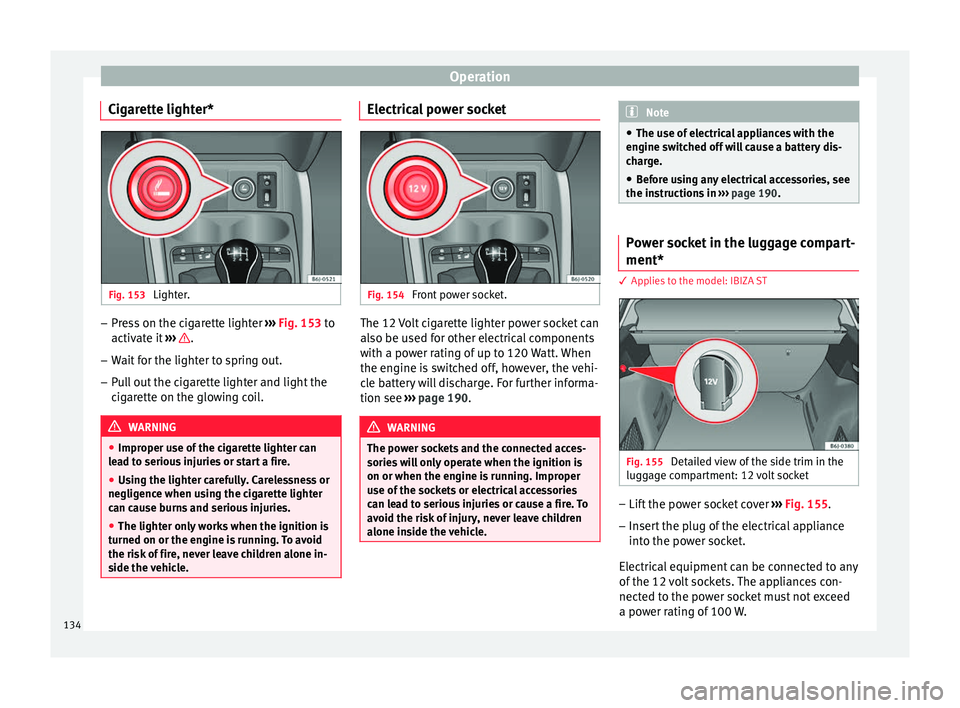
Operation
Cigarette lighter* Fig. 153
Lighter. â
Press on the cigarette lighter âºâº
âº
Fig. 153 to
activate it âºâºâº .
â Wait for the lighter to spring out.
â Pull out the cigarette lighter and light the
cig
ar ett
e on the glowing coil. WARNING
â Improper use of the c
igarette lighter can
lead to serious injuries or start a fire.
â Using the lighter carefully. Carelessness or
negligence when u
sing the cigarette lighter
can cause burns and serious injuries.
â The lighter only works when the ignition is
turned on or the engine is
running. To avoid
the risk of fire, never leave children alone in-
side the vehicle. Electrical power socket
Fig. 154
Front power socket. The 12 Volt cigarette lighter power socket can
al
so be u
sed for other el
ectrical components
with a power rating of up to 120 Watt. When
the engine is switched off, however, the vehi-
cle battery will discharge. For further informa-
tion see âºâºâº page 190. WARNING
The power sockets and the connected acces-
sories w i
ll only operate when the ignition is
on or when the engine is running. Improper
use of the sockets or electrical accessories
can lead to serious injuries or cause a fire. To
avoid the risk of injury, never leave children
alone inside the vehicle. Note
â The use of el ectric
al appliances with the
engine switched off will cause a battery dis-
charge.
â Before using any electrical accessories, see
the instructions
in âºâºâº page 190. Power socket in the luggage compart-
ment*
3 Applies to the model: IBIZA ST
Fig. 155
Detailed view of the side trim in the
lug g
ag e c
ompartment: 12 volt socket â
Lift the power socket cover âºâº
âº
Fig. 155
.
â Insert the plug of the electrical appliance
into the power soc
ket.
Electrical equipment can be connected to any
of the 12 volt sockets. The appliances con-
nected to the power socket must not exceed
a power rating of 100 W.
134
Page 137 of 252
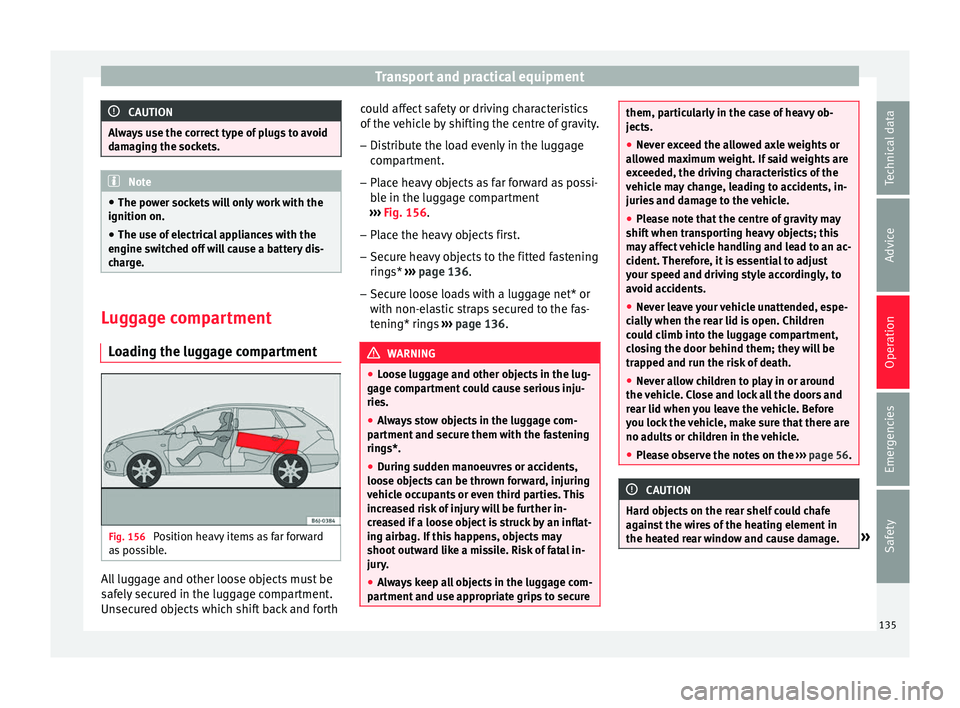
Transport and practical equipment
CAUTION
Always use the correct type of plugs to avoid
damagin g the soc
kets.Note
â The power soc k
ets will only work with the
ignition on.
â The use of electrical appliances with the
engine switc
hed off will cause a battery dis-
charge. Luggage compartment
Lo
adin
g the luggage compartment Fig. 156
Position heavy items as far forward
a s
po s
sible. All luggage and other loose objects must be
s
af
ely sec
ured in the luggage compartment.
Unsecured objects which shift back and forth could affect safety or driving characteristics
of the vehic
le by shifting the centre of gravity.
â Distribute the load evenly in the luggage
compartment
.
â Place heavy objects as far forward as possi-
ble in the lugg
age compartment
âºâºâº Fig. 156.
â Place the heavy objects first.
â Secure heavy objects to the fitted fastening
rings* âºâº
⺠page 136.
â Secure loose loads with a luggage net* or
with non-elas
tic straps secured to the fas-
tening* rings âºâºâº page 136. WARNING
â Loose lug g
age and other objects in the lug-
gage compartment could cause serious inju-
ries.
â Always stow objects in the luggage com-
partment and sec
ure them with the fastening
rings*.
â During sudden manoeuvres or accidents,
loose obj
ects can be thrown forward, injuring
vehicle occupants or even third parties. This
increased risk of injury will be further in-
creased if a loose object is struck by an inflat-
ing airbag. If this happens, objects may
shoot outward like a missile. Risk of fatal in-
jury.
â Always keep all objects in the luggage com-
partment and u
se appropriate grips to secure them, particularly in the case of heavy ob-
jects.
â
Nev er e
xceed the allowed axle weights or
allow
ed maximum weight. If said weights are
exceeded, the driving characteristics of the
vehicle may change, leading to accidents, in-
juries and damage to the vehicle.
â Please note that the centre of gravity may
shift when tran
sporting heavy objects; this
may affect vehicle handling and lead to an ac-
cident. Therefore, it is essential to adjust
your speed and driving style accordingly, to
avoid accidents.
â Never leave your vehicle unattended, espe-
cial
ly when the rear lid is open. Children
could climb into the luggage compartment,
closing the door behind them; they will be
trapped and run the risk of death.
â Never allow children to play in or around
the vehicl
e. Close and lock all the doors and
rear lid when you leave the vehicle. Before
you lock the vehicle, make sure that there are
no adults or children in the vehicle.
â Please observe the notes on the âºâºâº p
age 56. CAUTION
Hard objects on the rear shelf could chafe
agains t
the wires of the heating element in
the heated rear window and cause damage. » 135
Technical data
Advice
Operation
Emergencies
Safety
Page 138 of 252
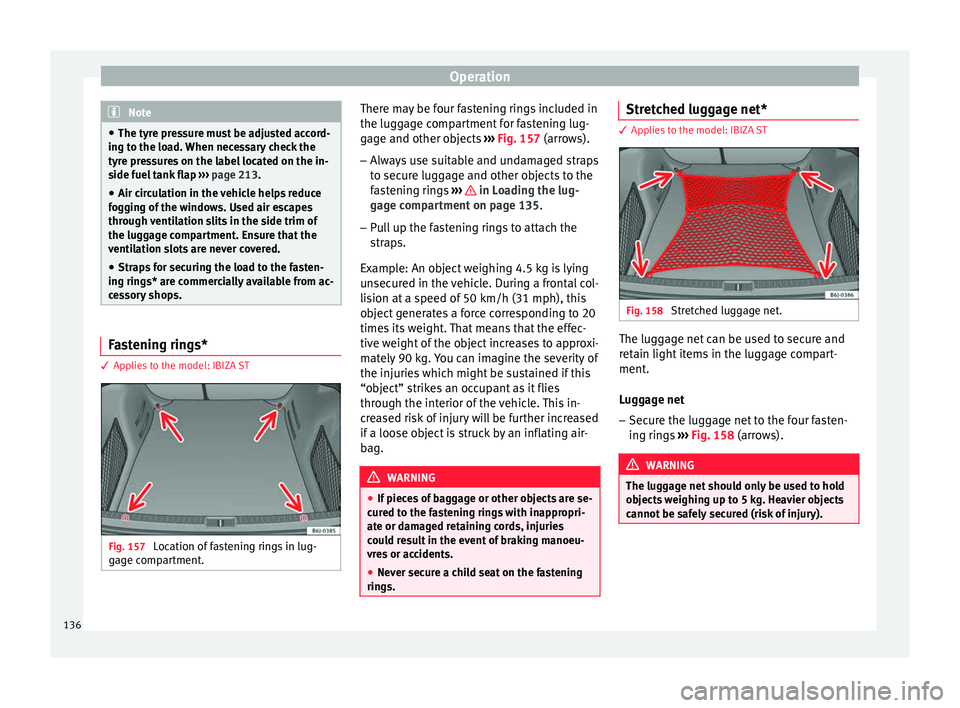
Operation
Note
â The tyre pr e
ssure must be adjusted accord-
ing to the load. When necessary check the
tyre pressures on the label located on the in-
side fuel tank flap âºâºâº page 213.
â Air circulation in the vehicle helps reduce
fogging of
the windows. Used air escapes
through ventilation slits in the side trim of
the luggage compartment. Ensure that the
ventilation slots are never covered.
â Straps for securing the load to the fasten-
ing rings* ar
e commercially available from ac-
cessory shops. Fastening rings*
3 Applies to the model: IBIZA ST
Fig. 157
Location of fastening rings in lug-
g ag
e c omp
artment. There may be four fastening rings included in
the lug
g
ag e c
ompartment for fastening lug-
gage and other objects âºâºâº Fig. 157 (arrows).
â Always use suitable and undamaged straps
to secure lug
gage and other objects to the
fastening rings âºâºâº in Loading the lug-
g ag
e c omp
artment on page 135.
â Pull up the fastening rings to attach the
straps.
Ex
ample: An object weighing 4.5 kg is lying
unsecured in the vehicle. During a frontal col-
lision at a speed of 50 km/h (31 mph), this
object generates a force corresponding to 20
times its weight. That means that the effec-
tive weight of the object increases to approxi-
mately 90 kg. You can imagine the severity of
the injuries which might be sustained if this
âobjectâ strikes an occupant as it flies
through the interior of the vehicle. This in-
creased risk of injury will be further increased
if a loose object is struck by an inflating air-
bag. WARNING
â If piece s
of baggage or other objects are se-
cured to the fastening rings with inappropri-
ate or damaged retaining cords, injuries
could result in the event of braking manoeu-
vres or accidents.
â Never secure a child seat on the fastening
rings. Stretched luggage net*
3 Applies to the model: IBIZA ST
Fig. 158
Stretched luggage net. The luggage net can be used to secure and
r
et
ain light it
ems in the luggage compart-
ment.
Luggage net
â Secure the luggage net to the four fasten-
ing rings
âºâºâº Fig. 158 (arrows). WARNING
The luggage net should only be used to hold
obj ect
s weighing up to 5 kg. Heavier objects
cannot be safely secured (risk of injury). 136
Page 139 of 252
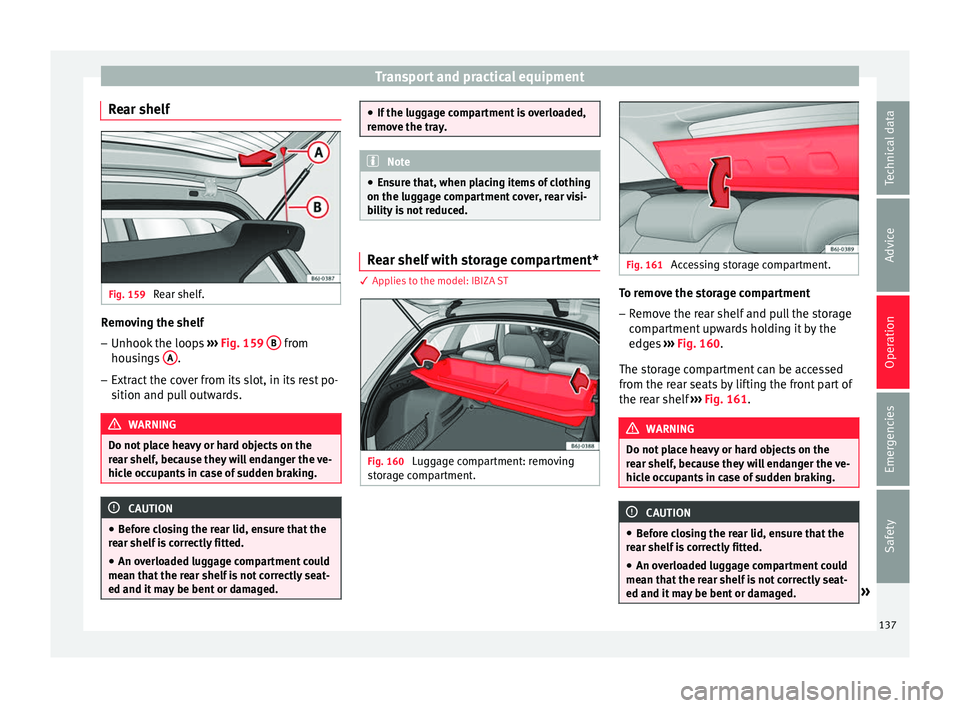
Transport and practical equipment
Rear shelf Fig. 159
Rear shelf. Removing the shelf
â
Unhook the loops âºâº
âº
Fig. 159 B from
hou s
in g
s A .
â Extract the cover from its slot, in its rest po-
sition and p
ul
l outwards. WARNING
Do not place heavy or hard objects on the
rear shelf , bec
ause they will endanger the ve-
hicle occupants in case of sudden braking. CAUTION
â Befor e c
losing the rear lid, ensure that the
rear shelf is correctly fitted.
â An overloaded luggage compartment could
mean that the r
ear shelf is not correctly seat-
ed and it may be bent or damaged. â
If the lugg ag
e compartment is overloaded,
remove the tray. Note
â En sur e th
at, when placing items of clothing
on the luggage compartment cover, rear visi-
bility is not reduced. Rear shelf with storage compartment*
3 Ap
plies to the model: IBIZA ST Fig. 160
Luggage compartment: removing
s t
or ag
e compartment. Fig. 161
Accessing storage compartment. To remove the storage compartment
â Remove the rear shelf and pull the storage
comp
artment
upwards holding it by the
edges âºâºâº Fig. 160.
The storage compartment can be accessed
from the rear seats by lifting the front part of
the rear shelf âºâºâº Fig. 161. WARNING
Do not place heavy or hard objects on the
rear shelf , bec
ause they will endanger the ve-
hicle occupants in case of sudden braking. CAUTION
â Befor e c
losing the rear lid, ensure that the
rear shelf is correctly fitted.
â An overloaded luggage compartment could
mean that the r
ear shelf is not correctly seat-
ed and it may be bent or damaged. » 137
Technical data
Advice
Operation
Emergencies
Safety
Page 140 of 252
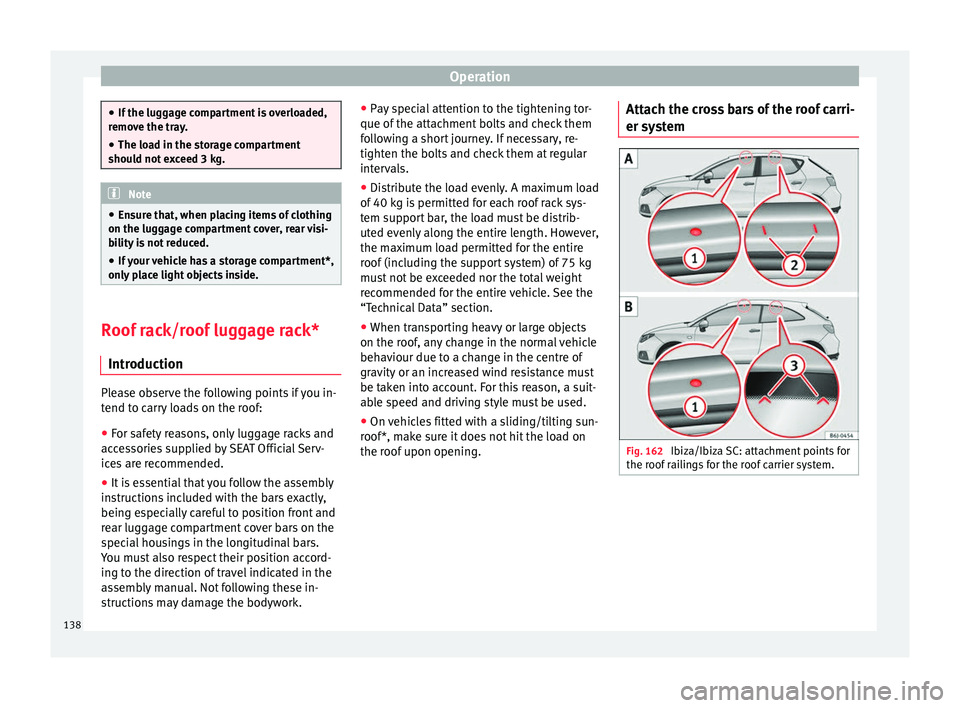
Operation
â
If the lugg ag
e compartment is overloaded,
remove the tray.
â The load in the storage compartment
should not e
xceed 3 kg. Note
â En sur e th
at, when placing items of clothing
on the luggage compartment cover, rear visi-
bility is not reduced.
â If your vehicle has a storage compartment*,
only pl
ace light objects inside. Roof rack/roof luggage rack*
Intr oduction Please observe the following points if you in-
t
end t
o carr
y loads on the roof:
â For safety reasons, only luggage racks and
acces
sories supplied by SEAT Official Serv-
ices are recommended.
â It is essential that you follow the assembly
instructions
included with the bars exactly,
being especially careful to position front and
rear luggage compartment cover bars on the
special housings in the longitudinal bars.
You must also respect their position accord-
ing to the direction of travel indicated in the
assembly manual. Not following these in-
structions may damage the bodywork. â
Pay s
pecial attention to the tightening tor-
que of the attachment bolts and check them
following a short journey. If necessary, re-
tighten the bolts and check them at regular
intervals.
â Distribute the load evenly. A maximum load
of 40 kg i
s permitted for each roof rack sys-
tem support bar, the load must be distrib-
uted evenly along the entire length. However,
the maximum load permitted for the entire
roof (including the support system) of 75 kg
must not be exceeded nor the total weight
recommended for the entire vehicle. See the
âTechnical Dataâ section.
â When transporting heavy or large objects
on the roof, any
change in the normal vehicle
behaviour due to a change in the centre of
gravity or an increased wind resistance must
be taken into account. For this reason, a suit-
able speed and driving style must be used.
â On vehicles fitted with a sliding/tilting sun-
roof*, make s
ure it does not hit the load on
the roof upon opening. Attach the cross bars of the roof carri-
er system
Fig. 162
Ibiza/Ibiza SC: attachment points for
the r oof
rai
lings for the roof carrier system. 138